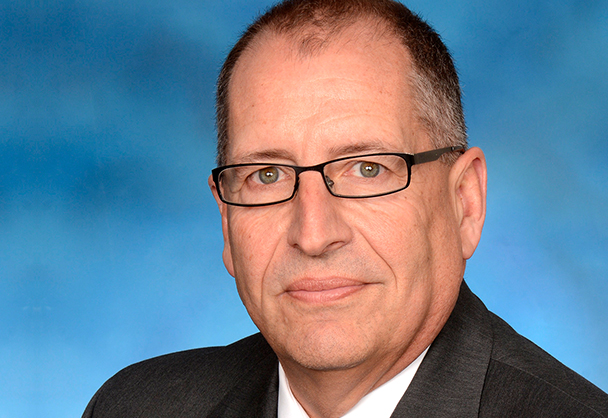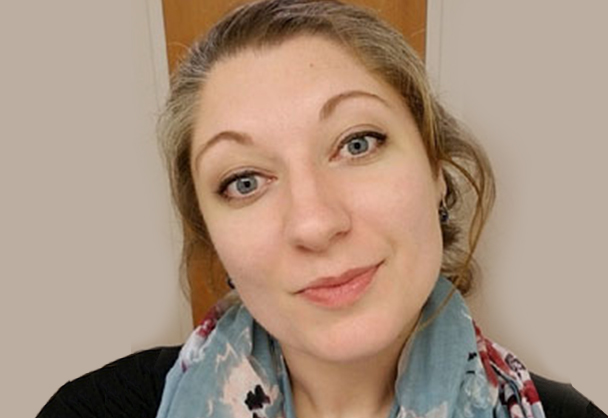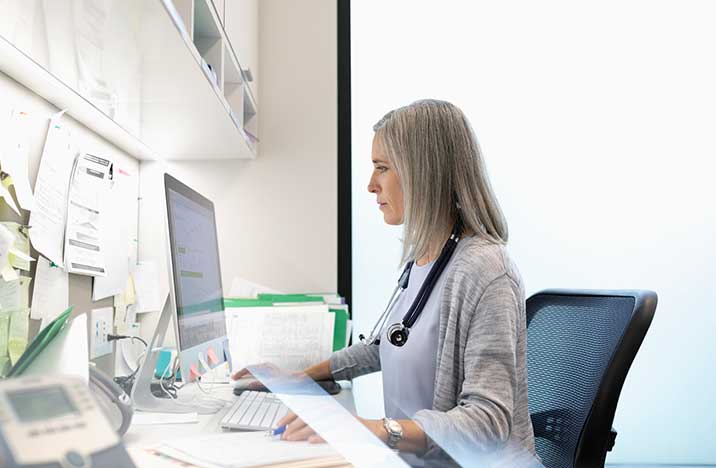Reverse Your Reliance on 503Bs for Compounded Sterile Products
Introduction
Learn how the University of Maryland Medical Center reversed its reliance on 503B vendors through an IV robotics insourcing program for compounded sterile products (CSPs). The result is a strategic services operation delivering advanced CSP services across its organization, resulting in improved safety, increased efficiency, and significant cost savings.

Joseph J. DiCubellis, RPh, MPH
Senior Director of Pharmacy Services for the University of Maryland Medical System and Senior Director of Pharmacy, University of Maryland Medical Center

Yevgeniya Kogan-Hardesty, PharmD, BCSC
Sterile Compounding Pharmacy Manager, University of Maryland Medical Center
Episode Highlights
Q: What challenges prompted you to start a CSP insourcing program?
Joe DeCubellis: From a business standpoint, one of the first things I noticed when I walked in the door more than six years ago was an unacceptable spend on 503B vendors. I saw an opportunity to save money without compromising safety or operations.
From an operational perspective, there were constant product shortages or other disruptions. To find the products we needed, we found ourselves moving from one 503B company to another. When we couldn’t get a product through a 503B, it fell back onto us to compound them.
Clinically, when you switch from a 503B compounded product to something that you make under a hood—or you ask a nurse to reconstitute and push—it gets quite complicated. You need to make changes in your electronic medical record (EMR) system. You have to notify clinicians. There's a lot of work involved.
Q: To regain control of the drug supply chain, what options did you consider?
Joe DeCubellis: We wanted to be less reliant on the 503B industry. That left several options:
- IV robotics, which I was familiar with from previous roles
- Workflow automation – I didn’t think we could bring all that compounding in house
- Manual preparation, which makes me nervous from a quality and consistency standpoint
Each of those options came with personnel challenges. Like other hospitals, we were struggling to retain the pharmacy technicians we relied on for this process. That’s when I learned about the insourcing program, which is basically contracting to produce a quantity of product for a price.
I really love that concept because it takes the pressure of scheduling and personnel off of us, but leaves us in charge of signing off on the final product. We talked about it as a team and all agreed the insourcing program was the right way to go.
Q: How did you go about getting leadership investment and ongoing support?
Joe DiCubellis: I had developed some—I guess I'll call it administrative capital—bringing forward other projects that were successful. The administration developed a comfort level with pharmacy initiatives that were improving patient care and also helping the hospital’s bottom line. So it was fairly easy to get the insourcing project going based on our recommendations and past results.
There are two parts to this:
First, I’m very conservative in what I bring forward. We go through an extensive due diligence, especially when a project needs resources or financial investment.
Second, while the financial benefit is important to leadership, so is being a technology innovator. We’re an academic medical center on the cutting edge of global breakthroughs—the world’s first pig heart transplant occurred right here a few months ago.
The insourcing project fits perfectly within the mission of the medical school–medical center partnership.
Q: What are the various first steps you took to implement your insourcing program?
Joe DeCubellis: We compared the data of our largest volume 503B spend items against the cost of producing them with our insourcing program. We came up with a Top 10 list. This showed an opportunity to save significant amounts of money. Getting these quick wins was very important to justify the investment as early on as possible, and allowed us to show administration the program could quickly pay for itself.
Most importantly, for this program to continue to grow and be successful, I knew we needed a dedicated leader. Jen’s skill set is so wide she could go from being a med safety pharmacist today to overseeing an oncology clinic and satellite tomorrow. We thought she would be ideal for this project. We elevated her to manager and basically entrusted the program to her. Without her leadership, there is no way that we would have gotten to where we are today with this program.
Q: What does your program look like today?
Jen Kogan: We’ve definitely come a long way. We’re delivering quite an array of drugs from syringes to bags of various sizes, and really spanning different types of services, from pediatrics to critical care to ORs.
We have four IV robots producing non-hazardous medications, operating Monday through Thursday, 15 hours per day. We outsource technician manpower to the IV Compounding Service. The insourcing program accounts for about 50% of our nonhazardous adult sterile products. We’re producing about 750 doses per day and 3,000 per week.
From the inception of the program to current state, we've definitely evolved and learned quite a bit. As we've grown, we’ve continued to see a big value in this program.
Q: What is the financial impact?
Joe DiCubellis: We set a year-one target to achieve $1 million in savings above and beyond all expenses for this program. We didn't quite make it in year one. It took us 15 months. Now, we're well beyond a million dollars in savings.
We calculate savings by taking the delta of what we would have spent on compounded products with 503Bs versus what we spend on our insourcing program. We also factor in the savings achieved by optimizing par level inventories stored in cabinets and elsewhere throughout the hospital. This is truly the net savings to the institution.
Jen Kogan: We also focus on cost avoidance, and believe it’s a novel way to approach inventory management. With our dynamic inventory model, we’re able to project the demand for certain products, and then produce only what is needed. This allows us to minimize waste. We consider this to be savings, because we’re spending less on drugs and supplies. It’s definitely an area we worked hard to develop.
Q: How have you changed your approach to managing inventory?
Jen Kogan: My goal was always to best optimize our inventory. There was a lot of analysis upfront using EMR data and other sources to understand the different products used, the supply and dispensing processes, the frequency, volume, and so forth for each product.
As we evolved the program, we looked at inventory optimization differently. We no longer look at traditional pars. We have enough data to be able to anticipate needs. We’re able to produce on demand—in line with the demand of our institutional needs and our patient needs—which allows us to more tightly control inventory, reduces our susceptibly to over- or under-purchase, and contributes to much less waste potential.
With how we approach inventory, we’re definitely able to better anticipate shortages, which shields our team and our staff from the uncertainties of the market. Because when you’re stuck by surprise, it's a lot of work, and you may be forced to make on-the-fly decisions that may not be the safest thing to do.
Q: What’s an example of how you’re able to better withstand the impacts of drug shortages?
Jen Kogan: We were purchasing hydromorphone from a 503B vendor. Suddenly, our supply was cut off. That's how it happens, right? All of a sudden and without notice. We had a high volume of COVID patients and our demand for hydromorphone was incredibly high.
Fortunately, with our insourcing vendor, we had completed a study on hydromorphone and were prepared for in-house robotics production. The insourcing robotics team jumped right in to support our staff.
Initially, they compounded short-dated hydromorphone bags, then extended-dating hydromorphone bags, all amounting to several hundred hydromorphone bags per week.
As you can image, producing controlled substances, the amount of accountability, the amount of paperwork that has to exchange hands, and then just the sheer amount of doses that we were able to make, it was pretty incredible.
We provided seamless care for our patients and the staff didn’t even notice a difference. It’s a great example of how the insourcing program can adapt and change, within reason, to support an ever-changing environment.
Q: Are you still using 503B vendors?
Joe DiCubellis: We're using 503B companies to a much lesser extent. We consolidated to basically two companies with about 80% of our business. It’s made our life easier in terms of sourcing products, shipping times, cost basis, and so on. Cutting down on the number of 503Bs has been one major benefit of our insourcing program.
Another benefit, from a supply chain standpoint, is that the robots are capable of utilizing products from multiple manufacturers. Should one company go short, we can fairly easily switch to another company's product to make our compounds. That’s made the shortages more tolerable because they’re more under our control.
DISCLAIMER
The Future of Pharmacy Podcast is produced and distributed by Pharmacy Podcast Network. The views and opinions expressed in this podcast are those of the authors and do not necessarily reflect the official policy or position of any other agency, organization, employer or company. Assumptions made in the analysis are not reflective of the position of any entity other than the author(s). These views are always subject to change, revision, and rethinking at any time and may not be held in perpetuity.
 Back to Podcast
Back to Podcast

